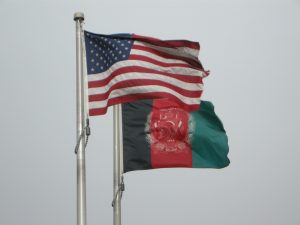Even the Taliban seem to know there will be a new American president come early 2021 and are angling for continued commitment to the deal signed in February 2020.
In a statement on November 10, the Taliban said that the U.S. election was an internal issue in the United States but wanted “to stress to the new American president-elect and future administration that implementation of the [Doha] agreement is the most reasonable and effective tool for ending the conflict between both our countries.”
The Taliban reiterate that the February 29, 2019 deal’s main points — in their view, a U.S. withdrawal, “non-interference” by the United States in Afghanistan, and the Taliban prohibiting the use of Afghan soil to threaten the United States — remain in the interest of both sides. The group, which the United States ousted from power in Afghanistan in October 2001, says it remains committed to the agreement.
The Taliban go on to urge that the “future American president and administration need to be vigilant of war-mongering circles, individuals and groups that seek to perpetuate the war and to keep America mired in conflict in order to pursue their own personal interests and hold over power.”
What a Joe Biden administration means for the U.S. war in Afghanistan, the planned U.S. exit, and the peace process may not be the hottest of foreign policy topics within the context of the transition of U.S. administrations. As Abubakar Siddique explains in an analysis this week, citing a bevy of experts, the consensus view seems to be that the administration of President-elect Biden will “tweak but not completely change the U.S. course in Afghanistan…”
Elizabeth Threlkeld of the Stimson Center told Siddique that “In general, any changes will be more in tone and process than on substance.” Others note that Biden, who chaired the U.S. Senate’s Foreign Relations Committee in early 2001, mid-2001 to 2003, and again in 2007 to 2009, may hold more firmly to “conditions” for a withdrawal but the direction of policy won’t change dramatically.
Indeed, when Donald Trump took office in January 2017 the administration of Barack Obama, in which Biden was vice president, had maneuvered the U.S. toward a withdrawal in various fits and starts.
When Obama took office in January 2009, there were a little more than 30,000 U.S. troops in Afghanistan. That force surged to a high of more than 100,000 by 2010. By 2014, troop levels had come down to around the same mark — 34,000 — as when Obama entered office and he instructed military leaders to chart a course for a full withdrawal as then-Afghan President Hamid Karzai had refused to sign a bilateral security assistance (BSA) agreement that would give legal grounds for the U.S presence. New Afghan President Ashraf Ghani signed a BSA with the United States in the fall of 2014 but the Obama administration was then still aiming for a withdrawal, with 2016 the ambition at the time.
Meanwhile, over the years Republican lawmakers in the United States sharply criticized Obama for his withdrawal plans. In 2011, Senator John McCain criticized Obama’s plan at the time as not modest enough and Senator Lindsey Graham, as the Guardian reported, described it “as a victory for vice-president Joe Biden, who has long advocated reducing the US presence…” In 2015, as the Obama administration adjusted its timetable the same pair of senators welcomed the slowdown of the withdrawal while also criticizing Obama for “maintaining… [a] calendar-driven deadline.”
By the time Trump took office there were around 8,400 U.S troops left in Afghanistan. Trump espoused an intent to withdraw the United States from Afghanistan but surged troops instead, aiming to bring U.S. force levels back to around 14,000 under his administration’s South Asia strategy, laid out in August 2017. The strategy stressed that a withdrawal would be based on “conditions on the ground, not arbitrary timetables.”
Nevertheless, with the signing of the agreement in February 2020, the Trump administration set out a 14-month timeline: A U.S. drawdown to 8,600 within 135 days (July 13, 2020), and down to zero within another nine and a half months (May 2021).
Whether that timetable remains in play is a critical question.
The Taliban’s apparent acceptance of a coming Biden administration and urging it to stay the course is juxtaposed by Afghan government officials airing hopes for a tougher stance from Washington. Even as the Taliban and the Afghan government continue to negotiate in Doha, where intra-Afghan talks began in September, attacks in the country have continued alongside allegations that the Taliban are not upholding their end of the deal.
Sarwar Danish, Afghanistan’s second vice president, on Monday called for Biden to conduct a “full review” of the peace process and “apply more pressure on the Taliban to reduce their violence.”
An Afghan official told the Washington Post, “The biggest change we expect is in how policy is implemented… We expect more predictability, a more coordinated withdrawal.”

































